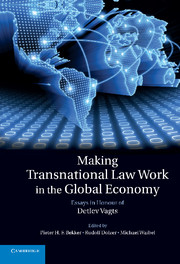Book contents
- Frontmatter
- Contents
- List of contributors
- Foreword: the transnationalism of Detlev Vagts
- List of cases cited
- List of abbreviations and acronyms
- Introduction: a Festschrift to celebrate Detlev Vagts' contributions to transnational law
- 1 Detlev Vagts and the Harvard Law School
- 2 Constructing and developing transnational law: the contribution of Detlev Vagts
- I International law in general
- II Transnational economic law
- III Transnational lawyering and dispute resolution
- 23 Diffusion of law: the International Court of Justice as a court of transnational justice
- 24 Regulating counsel conduct before international arbitral tribunals
- 25 International arbitrators as equity judges
- 26 Customary international law, Congress and the courts: origins of the later-in-time rule
- 27 Mediation and civil justice: a public–private partnership?
- 28 The borders of bias: rectitude in international arbitration
- 29 Managing conflicts between rulings of the World Trade Organization and regional trade tribunals: reflections on the Brazil – Tyres case
- 30 Cross-border bankruptcy as a model for the regulation of international attorneys
- Bibliography of Detlev Vagts
- Index
26 - Customary international law, Congress and the courts: origins of the later-in-time rule
from III - Transnational lawyering and dispute resolution
Published online by Cambridge University Press: 17 November 2010
- Frontmatter
- Contents
- List of contributors
- Foreword: the transnationalism of Detlev Vagts
- List of cases cited
- List of abbreviations and acronyms
- Introduction: a Festschrift to celebrate Detlev Vagts' contributions to transnational law
- 1 Detlev Vagts and the Harvard Law School
- 2 Constructing and developing transnational law: the contribution of Detlev Vagts
- I International law in general
- II Transnational economic law
- III Transnational lawyering and dispute resolution
- 23 Diffusion of law: the International Court of Justice as a court of transnational justice
- 24 Regulating counsel conduct before international arbitral tribunals
- 25 International arbitrators as equity judges
- 26 Customary international law, Congress and the courts: origins of the later-in-time rule
- 27 Mediation and civil justice: a public–private partnership?
- 28 The borders of bias: rectitude in international arbitration
- 29 Managing conflicts between rulings of the World Trade Organization and regional trade tribunals: reflections on the Brazil – Tyres case
- 30 Cross-border bankruptcy as a model for the regulation of international attorneys
- Bibliography of Detlev Vagts
- Index
Summary
Introduction
Transnational law, in Philip Jessup's classic definition, is ‘all law which regulates actions or events that transcend national frontiers’. This means that transnational law includes not only international law but much domestic law, and since international and domestic law often bear on the same subjects, questions about their relationship frequently arise. In the United States today, the relationship between Federal statutes and international law is well settled. According to section 115 of the Restatement (Third) of Foreign Relations Law of the United States, ‘An act of Congress supersedes an earlier rule of international law or a provision of an international agreement as law of the United States if the purpose of the act to supersede the earlier rule or provision is clear or if the act and the earlier rule or provision cannot be fairly reconciled’. US courts will interpret Federal statutes to avoid such violations, but in cases of clear conflict the later-in-time prevails.
It has not always been thus. At the time of the framing, the common understanding was that treaties were ‘beyond the lawful reach of legislative acts’. John Jay explained in The Federalist that as the consent of two nations was required to make treaties, ‘so must it ever afterwards be to alter or cancel them’. In a 2001 article, Detlev Vagts traced the judicial origins of the later-in-time rule for treaties to the mid-nineteenth century.
- Type
- Chapter
- Information
- Making Transnational Law Work in the Global EconomyEssays in Honour of Detlev Vagts, pp. 531 - 559Publisher: Cambridge University PressPrint publication year: 2010



